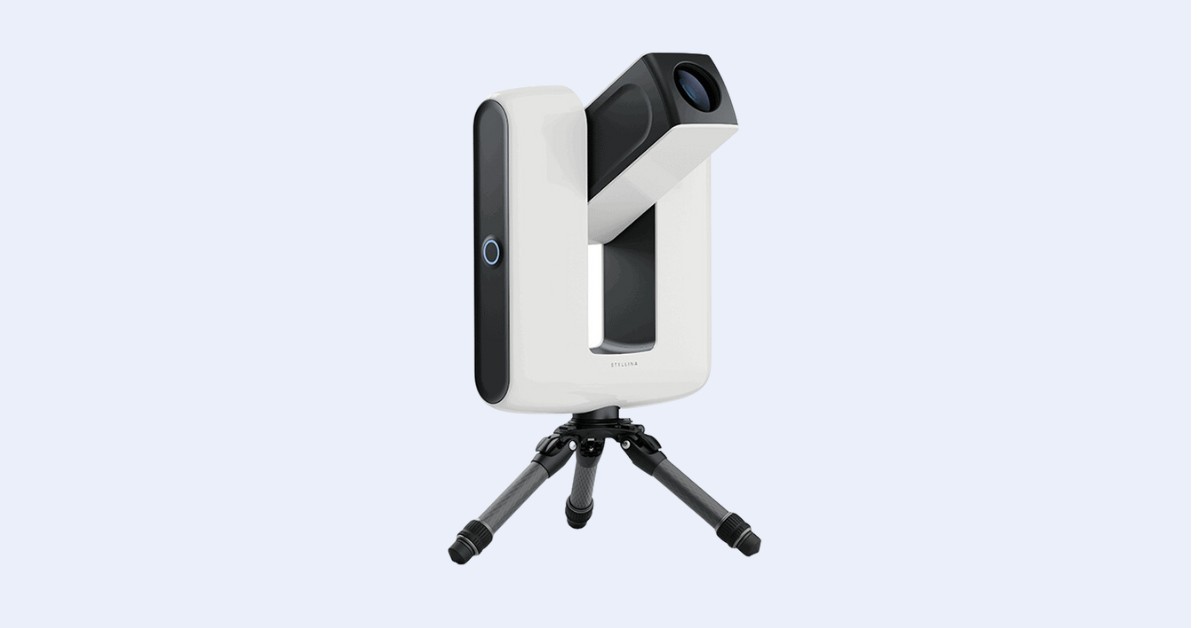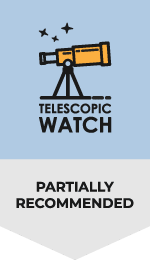Analysing The Optical Tube
The optical tube of the Vaonis Stellina is a very seamless-looking 80mm (3.2”) f/5 doublet refractor, with a resulting 400mm focal length, built into a shiny white plastic tube.
With the scope’s somewhat small aperture and lightweight materials, the setup in its entirety only weighs 25 pounds. Most of the components used to assemble the Vespera are made of plastic, which is helping to keep the weight down. However, what I can’t imagine is that if I drop it accidentally, the telescope could easily be damaged. With the lack of carrying handles on the tube or the mount, it’s a bit worrying for sure.
At this price point, I expected the refractor to be a triplet, but I was wrong. The Stellina is only a doublet, which unfortunately leaves a little bit of room for chromatic aberration in the images. While it’s not always the number of lens elements that determines the overall color correction, it would’ve definitely let people like me know that Vaonis went the extra mile in quality by utilizing a triplet refractor. Luckily, the optics are at least apochromatic and are made of extra-low dispersion (ED) lanthanum glass to keep the chromatic aberration very low.
Because Vaonis went with a refractor design rather than a reflector like the Unistellar eVscope 2, collimation isn’t a concern either with the Stellina, which is nice. The scope also has a built-in field flattener.
Inside the optical tube, there’s not much to look at besides the black interior, the two lens elements, and the sensor toward the back of the scope. I particularly like that the inside walls are adequately dark, which is important for maintaining good contrast in the images.
Unlike its smaller cousin, the Vespera, the Stellina does not have a designated attachment point for filters or a hygrometer sensor on the front of the telescope. However, Vaonis does offer a Stellina solar filter that I can seat to fit over the primary objective.
Given that the telescope is a refractor, I’m particularly concerned about humid nights due to the dew issue. Telescopes like the Vespera do have a dew heating system, but it can only be used if I purchase a separate hygrometer sensor from them. Luckily, the Stellina includes a hygrometer sensor built into the telescope, as well as a band of resistors around the lenses that heat up the elements and prevent condensation from forming. On top of that, Stellina also has a built-in rain sensor that will close off and shut down the telescope to protect itself from water damage.
Another nice feature of the Stellina that other comparable smart telescopes don’t include: a field derotator. Most people would consider this a superficial thing, but it’s definitely nice to have it for when I want to take extremely long exposures without star trailing.
The Adequate Camera Sensor
The imaging portion of the Vaonis Stellina consists of a 1/1.8” Sony IMX178 camera sensor. At 6.4 megapixels (3096 x 2080), this is enough to provide crisp, high-resolution images of the night sky. The Sony IMX178 performs very nicely in low-light conditions, which is exactly what the observation station is supposed to be optimized to do. Combined with the optical system, you can expect to have a field of view of 1 degree by 0.7 degree, or a magnification of 50x.
A light pollution filter is also permanently installed in front of the sensor, which helps with contrast, especially in urban environments.
The Power-Hungry Electronics
Unfortunately, with this power-hungry chip and other electronics within the telescope, the included 10,000 mAh battery is only enough to last for up to five hours of continuous use, which sometimes wasn’t enough for me. It can be plugged into a wall charger while being used, but for remote observing locations, this is a pretty major inconvenience. Competing telescopes like the eVscope eQuinox feature 11 hours of battery life, more than double that of the Stellina.
The Android/iOS App: Singularity by Vaonis
Vaonis offers a sleek, efficient app for both Android and Apple smartphones and tablets to control the Stellina. To use the Singularity app, up to five devices can simultaneously join Stellina’s broadcasted wireless access point and connect to the telescope.
Upon opening the app and connecting, the alignment process begins to work by using our smartphone or tablet’s internal GPS. After it has located itself on the globe, it takes about three to five minutes to orient itself by using its internal star database with a plate-solving algorithm.
The Stellina, with the Singularity app, does almost everything automatically to make my observing session a seamless and enjoyable experience.
For people wanting a little bit more manual ability, you can control the Stellina’s rough and fine movements, focus, and exposure settings in the app if you so desire, as well as dial in manual coordinates for unlisted objects. I can also export my stacked images as compressed JPEGs or uncompressed file formats such as TIFF or FITS for post-processing on a PC.
One of my least favorite things about the app is the disappointingly small library of objects. Currently, there are somewhere around 300 objects in Singularity’s database, but more are slowly added with each software update. Considering that competitors like Unistellar have more than 5,000 objects in their app’s library, this is simply inexcusable. As mentioned before, I can manually enter sky coordinates into the Singularity app, but that is far less convenient than having the objects at the touch of a button.
The Adequate Dual Fork Mount & Tripod
The Stellina is mounted on dual motorized fork arms covered with the same thin white plastic used on the two faces of the optical tube, which gives the observation station a very smooth appearance when parked in the home position.
The package also includes a short, adjustable tripod with a bubble level that seems sturdy enough to me to do the job. Since the tripod is very low to the ground, wind isn’t too much of a concern. I’m not looking through this scope anyway, so there isn’t much of a need for a tall tripod.
The tripod comes with small rubber feet on the bottom, which are more useful for preventing it from sliding than it is for vibration suppression. If I use the Stellina on a solid surface, such as a concrete pad, then this works just fine in most cases.
The motorized mount is nice and quiet when slewing, but I guess that’s probably because it moves incredibly slowly. Upon pressing the button on my target in the app, it takes a bit to get it centered and tracking, especially if it’s on the opposite half of the sky from where I’m pointed. Besides that, I’ve got no complaints, and the pointing system is very accurate.
Performance on Solar System and Deep Sky Targets
One of the weak points I see of the Vaonis Stellina is Solar System targets, primarily planets.
Most of the planets, especially smaller ones like Venus and Mars, just appear as unresolved points in the images. On a good night, the cloud bands of Jupiter and the rings of Saturn appear in the Stellina, but it’s not breathtaking by any means. The Moon does fit nicely in Stellina’s field of view, but it isn’t exactly jaw-dropping due to this scope’s specs. This is a deep-sky astrophotography rig, after all.
The Stellina can capture most large globular clusters, and with well-resolved stars at that. Since the Stellina features a built-in light broadband pollution filter, overall contrast on objects like M82 or M31 is still limited to my sky conditions, but the Stellina performs slightly better than an unfiltered astrophotography rig in urban environments.
Big, bright objects like the Orion Nebula (M42), Lagoon Nebula (M8), or Pleiades (M45) are awesome targets for the Stellina, even in moderately light-polluted areas, given that I’ve provided enough time for the telescope to stack multiple exposures.
Should I buy a Used Vaonis Stellina?
Because the Stellina is an all-in-one package, it’s not something that you could replace or repair easily like many consumer-grade telescopes, so I do not recommend buying one pre-owned.
Vaonis does offer a 2-year warranty from the day you receive the telescope that covers defects, but if the Stellina was abused or modded in any way, the warranty is void, and there’s not much you can do about it.
Alternative Recommendations
While a 1:1 direct alternative to Stellina doesn’t exist, you should consider putting together your own telescope optical tube assembly, mount, and camera for an astrophotography setup at this price range – and you’ll be able to put together one far more capable than Stellina too. Alternatively, consider one of the scopes below.
- The Vaonis Vespera is a similar all-in-one package to the Stellina, but smaller and more simple than the Stellina.
- The Celestron Nexstar Evolution 8 is way larger than the Stellina but has a good built-in battery and wifi. You can observe with this telescope using either an eyepiece or a camera of your choice for electronically assisted astronomy.
- The Sky-Watcher 12” Flextube Collapsible Dobsonian is a great choice for those who want a hefty aperture while still desiring portability. A GoTo version is available as well, but it’s not a convenient, integrated package like the Stellina.
- The Sky-Watcher Virtuoso GTi 150P is one of the cheapest GoTo options on the market but is surprisingly comparable to the Stellina, just without the camera. However, the focuser supports most light planetary cameras for simple astrophotography.
Aftermarket Accessories Recommendations
The selection of available accessories for the Stellina from Vaonis is more limited than for the smaller version of the telescope, the Vespera.
Rather than having a separate light pollution filter (built-in over the sensor), dual-band filter, and solar filter, the Stellina only has a solar filter available to fit over the aperture. If sunspot observing is a priority for you, then I recommend investing in the Vaonis solar filter. Alternatively, you can purchase cheaper aftermarket solar filters that can fit the aperture, as long as you make sure it is secure and take proper precautions. Do NOT point the Stellina at the sun without a solar filter securely in place. While it can’t damage your eyes on the Stellina, it can burn the camera sensor or even set the whole thing on fire.
Lastly, if you want to travel anywhere with the telescope, I also recommend purchasing a padded backpack or case to protect your pricey investment. This could be the actual Stellina backpack or another fitting aftermarket one.
Optionally, you can also invest in a taller tripod. I personally wouldn’t recommend this because the Stellina could be more affected by wind and vibrations when further off the ground, and there’s no point in having it higher off the ground since there’s no eyepiece. Vaonis’ tall tripod is incredibly overpriced for what it is, but you can also just use most standard camera tripods that utilize a ⅜”-16 threaded screw.



